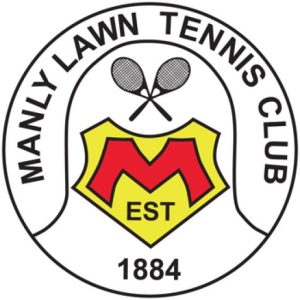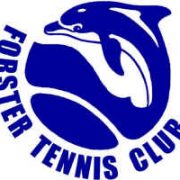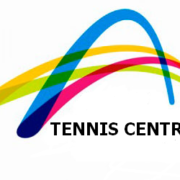A Good String Job Can Manage Your Limitations | AskThePro
/in Ask the Pro /by manly_adminIn our previous column on rackets, we make reference to the key advantages of a good restring in managing your limitations!
The tournament pros are absolutely fanatical about their choice of strings and the associated string tension — which they change to suit both surface and playing conditions — and often during a match. I still carry two rackets in my bag each with a slightly different tension to accommodate the changing playing conditions at Manly Lawn.
Conversely, our average tennis player puts what I euphemistically call “two dollars worth of nylon” in a $200+ high performance frame — and expects to play consistently well and without injury, especially tennis elbow.
Most club players who play two or more times a week are well advised to get a GOOD STRING JOB every 8 to 10 weeks depending on the season. Aggressive players who blast the ball with big western forehands need to update every 3 to 4 weeks or so. Yep, strings go loose and dead — and performance suffers!
Trust me when I say, your game will improve at least a POINT A GAME with a good restring! You might even be encouraged to take a few lessons to help better manage the rest of your limitations.
So what constitutes a GOOD STRING JOB?
First a little science education since modern strings come in different materials and thicknesses, each designed to suit different playing styles. In the table below, you’ll notice the differences in the main and cross strings and the dependence on whether you want control, power, comfort (did I mention managing tennis elbow?).

Thickness is pretty screwy since 18 gauge string is thinner than 16 gauge, go figure!
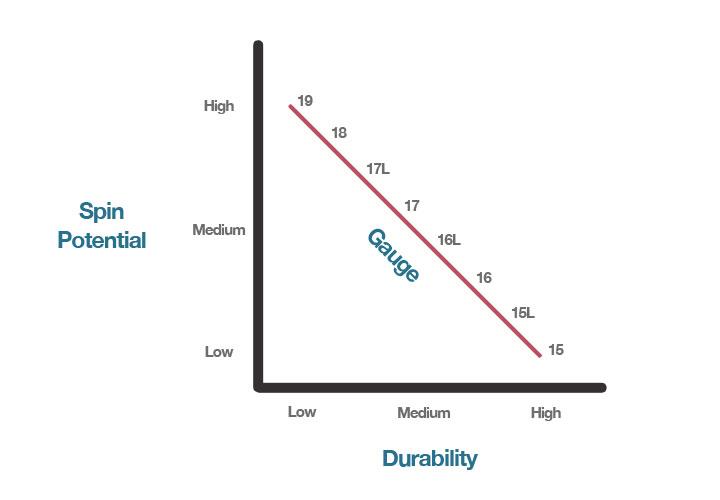
You can see from the graph above that the typical $2 nylon (16G) has high durability (to ensure rackets have a good shelf life) and low spin potential ( aka “feel/control”)! How did that new Wilson play with the $2 nylon strings?
Even at my tender age, I still use a hybrid combination of 18G multifilament Gamma Live Wire on the mains and Babolat Blast (Nadal’s string) on the crosses. Yep as I’ve aged and reverted to social player status, I’ve gone for more control and less power by reversing the mains and the crosses per the table. The 18G Live Wire is more lively (plays like gut) and gives me much more feel. The Blast allows me to give the ball a nudge and more topspin when I need to.
And now the string tension. Most players string the crosses the same as the mains and expect the tension to be even itself out throughout the racket during stringing. Well that’s the logic anyway. The GOAL was always to get an even string tension in the racket to increase the ‘sweet spot’. Yep, for most of my playing life I relied on that logic too. Of course my ball watching was so much better than, and I played with gut, so miss hits were infrequent. And yep it’s SOoooooo Wrong!
Several years ago I ran into a older, chain smoking racket stringer in California who set me straight — and he didn’t hold back! Turns out that what most people miss is the impact of FRICTION on the Crosses when you’re feeding the string under and over through the Mains. Whatever tension you string the Mains at, you ADD 5lb to the Crosses to counter the friction. Here’s my current stringing pattern to illustrate this key point:
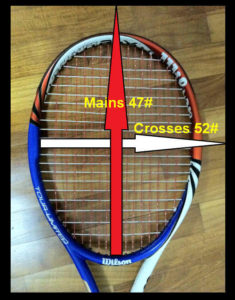
So Obi Wan how should I translate this to my game? Well most rackets come with a suggested stringing guide for tension. Start with the mid range for the racket for the Mains and then string the Crosses 5lb more. Then adjust up and down as required until you’re comfortable with the tension. Aside, typically you can use a lower tension that the one you used previously; helps your feel and control.
Just ask Tommie for ‘Rob’s restring’ if you want to try this type of restring at the Manly Tennis Centre. You’ll find an immediate benefit of a bigger sweet spot — and most of your misshits will go over now as your control is significantly improved.
As for the choice of string, well that depends on your game. I’ve given you the guidelines in the table above which you can probably figure out yourself. Even so, probably better to go talk to Scottie when you want some pro advice about what strings may suit your individual playing style. Or ask me.
To repeat you’ve got to manage your limitations — and using better technology (whether frame and/or strings) is a great way to do this. Cunning and guile will only get you so far! Invest in the technology!
Make a regular investment in a GOOD STRING JOB using the latest materials technology; it’s absolutely worth it for your psyche alone!
Sincerely,
Tennis Whisperer
MLTC Newsletter – 12 July 2022
/in Goss /by manly_adminThe Mixed Tournament last Saturday was a great success with everyone enjoying the tennis and camaraderie. A big thanks to Sarah for organising the day. Also a thank you to Gavin and Hugo for cutting the strawberries. Thanks to Milton for the Pimms drinks and for organising the meat.
If anyone has any ideas for other tournaments please let us know.
Round 9 commences this Saturday with the Mens 1 Team looking for a win to get back into the top 4 . They play at home at 2.50pm.
We have 5 teams in the top 4 at this stage and looking good for the semis.
SOCIAL TENNIS IS ON 2 COURTS ONLY FROM 11.30AM TO 2.30PM.
Best wishes,
Virginia
Djokovic Defeats Kyrgios For 7th Wimbledon Title | ATP
/in Goss, News /by manly_adminNovak Djokovic produced a returning masterclass to surge to a 4-6, 6-3, 6-4, 7-6(3) victory against Nick Kyrgios in Sunday’s final at Wimbledon, where the top seed claimed his fourth consecutive crown at the grass-court major.
Rallying from dropping the first set for the third straight match, Djokovic claimed a seventh title to draw level with Pete Sampras‘ mark at the All England Club. The 35-year-old Djokovic is now just one behind Roger Federer’s record of eight Wimbledon triumphs, and one Grand Slam title behind Rafael Nadal’s record of 22 major crowns.
“I have lost words for what this tournament, this trophy means to me, my team, my family,” said Djokovic at the trophy presentation. “I’ve said this many times. It always has been and always will be the most special tournament in my heart, the one that motivated me, inspired me to start playing tennis in a small mountain resort in Serbia where my parents used to run a restaurant.
“I was four or five years old and I saw Pete Sampras win his first Wimbledon in 1993. I asked my Dad and Mum to buy me a racquet, and my first image of tennis was grass and Wimbledon. I always dreamed of coming here, just playing in this court, and then realising the childhood dream of winning this trophy. Every single time it gets more meaningful and more special, so I’m very blessed and very thankful to be standing here with the trophy.”
Most Grand Slam Titles
| Player | Grand Slam Titles |
| Rafael Nadal | 22 |
| Novak Djokovic | 21 |
| Roger Federer | 20 |
| Pete Sampras | 14 |
After some scintillating Kyrgios shotmaking took him to the opening set on Centre Court, Djokovic found his rhythm on return to take the upper hand in an intriguing clash of game styles. Despite his opponent firing 30 aces in a three-hour, one-minute encounter, the top seed was clinical in taking his chances, most notably when he crucially broke Kyrgios’ serve after the Australian had led 40/0 at 4-4 in the third set. A nerveless showing from Djokovic in the fourth-set tie-break, his first of the tournament, sealed the victory and extended his winning streak at SW19 to 28 matches.
Although his ability to counter Kyrgios’ huge serving was key to Djokovic’s win, the Serbian was just as efficient with his own delivery. The top seed fired 15 aces and won 83 per cent (62/75) of points behind his first serve, compared to Kyrgios’ 70 per cent (64/91).
It marks another hard-fought triumph for Djokovic this week in London, where he overhauled a two-sets-to-love deficit to defeat Jannik Sinner in the quarter-finals and rallied from dropping the first set to Cameron Norrie in the semi-finals. The Serbian also defeated Soonwoo Kwon, Thanasi Kokkinakis, Miomir Kecmanovic and Tim van Rijthoven this fortnight in London.
DO WE LIKE KYRGIOS? IT’S COMPLICATED | SMH
/in Ask the Pro, Goss, News /by manly_adminWimbledon still has a couple of days to go, which is helpful because 48 hours gives us time to have another 48 opinions on Nick Kyrgios, to add to the thousands we’ve had on Kyrgios over the past eight years. This is Australia in 2022: Girt By Nick.
Kyrgios is now a human hottake generator, in that the endless hot takes on him now generate their own hot takes about the earlier hot takes, and on and on until we die. You’re reading one right now, so please watch for any sudden change in your vital signs.
To sum up our rollercoaster journey with the tennis terror from Canberra, let’s go to the social media-speak Nick himself loves so much: It’s Complicated. WTAF. FFS. And so on.
Because let’s be honest: it’s as easy to write the column ‘‘ Ten Reasons To Love Nick Kyrgios’ ’ as it is to write the column ‘‘ Ten Reasons To Hate Nick Kyrgios’’ .
You can sensibly and sarcastically wonder out loud what it is the Kyrgios fans love about him. Is it the verbal abuse? The violent treatment of racquets and balls? The spitting? The tanking? The narcissism? Equally, you can ask the Kyrgios haters what it is they hate. Is it the breathtaking talent? The shotmaking audacity? The charming impudence of his approach to the game’s stuffed shirts? His refreshing honesty that winning isn’t everything? What’s not to love? And what’s not to hate?
Kyrgios contains multitudes, and it is entirely possible that by Monday he will also contain a Wimbledon title, a triumph that will challenge us to reconsider him once again. Rarely have Australian sports fans been presented with a dilemma quite like the one we face this weekend.
As a lifelong tennis nut, my own journey with Kyrgios has been long and complicated. I remember the time he first made me sit up with a start in the middle of the night, saving nine match points on his way to the Wimbledon quarter-finals in 2014. Everything seemed possible then. I loved the guy, and I’ve spent a lot of money supporting him, flying to Darwin to watch him in the Davis Cup, and finding myself sitting next to Ken Rosewall at Rod Laver Arena the night Kyrgios played Nadal at the Australian Open in 2020.
Rosewall (who seemed bemused by Kyrgios more than anything else) never won Wimbledon, but he was a living reminder of a time when Australians always did. From 1922 to 1972, Australian players hoisted the men’s trophy 18 times. In the 50 years since, we’ve managed it just twice, Pat Cash in 1987 and Lleyton Hewitt in 2002.
We desperately want another man to win the greatest title, but Kyrgios – with as much raw talent as any Australian player has ever had – complicates the hope. And some of that is actually quite simple for some of the reactions: it’s racism. But racism does not explain all or even most of the contentious relationship.
I fell off the Kyrgios bandwagon last year, and after eight years of ferocious loyalty I’m finding it very hard to get back on it – even with a Wimbledon title in sight. The eternal promise had given way to eternal complaining. The bad behaviour too often crosses the line. The self-aggrandisement – the boasting about his crowd sizes and his self-proclaimed stature as the saviour of modern tennis – almost echoes Trump in its narcissism.
And so here we are, wondering what comes next.
Perhaps we can look to the past to summon some optimism. Hark back to John McEnroe, who was literally persona non grata at Wimbledon (they refused him the honorary club membership given to all champions) until his genius and his grit turned him into a beloved elder of the sport.
Ditto with Andre Agassi. He even boycotted Wimbledon for years because of the all-white dress code. Then he turned up, wearing white tracksuit pants like a spirit returned from the 1920s, and won the whole show. Agassi 2.0 was born right there on the hallowed London lawns, past demons cast aside.
Could history repeat? Will we come to love Kyrgios like we did those tennis toddlers of the past? We’re about to find out if Nick can wake up to the fact that the grass really is greener on the other side.
Neil McMahon is a freelance writer.
MTC Night Competitions Term 3
/in Tennis Centre /by manly_adminEntries for Term 3 Close July 15
Entries are now open online for Term 3 comps.
Entries close July 15 for both competitions.
Tuesday comp starts July 19 and Wednesday comp starts July 20.
Reserve players always welcome. For more information, please contact or email Scott.
Sign up on the web below.
Scott Blackburn
MTC Tennis Director & Head Pro
MTC Ladies Competitions Term 3
/in Tennis Centre /by manly_adminEntries for Term 2 Close July 15
Enrolments are now open online for Term 3 comps.
Entries close July 15 for both competitions.
Tuesday comp starts July 19 and Friday comp starts July 22.
Reserve players always welcome. For more information, please contact or email Scott.
Sign up on the web below.
Scott Blackburn
MTC Tennis Director & Head Pro
WIMBLEDON’S STRICT DRESS CODE IS NOT ALL-WHITE | SMH
/in Goss, News /by manly_adminMLTC Newsletter – 4 July 2022
/in Club News /by manly_adminWe are delighted to say we have new LED lights on courts 5 and 6. A big thank you goes to our President Craig for all his work coordinating this and managing to get grants to help cover much of the cost.
Please see the photo of our Manly team when they played against our Prime Minister’s team last week.

Best wishes,
Virginia
MLTC Secretary
Coaching Comes Out of the Shadows
/in Ask the Pro, News /by manly_adminOne of the last barriers separating tennis from other sports came tumbling down on Tuesday, when the ATP and even the USTA opted to allow coaching during matches on a trial basis for the rest of 2022. The trial starts immediately after Wimbledon, and when the US Open unspools in late August, it will mark the first time that any type of coaching is permitted at a Grand Slam tournament.
We know what tennis lost in this transaction: The distinction of being the one major sport in which the athlete, even in the heat of competition, must be a self-reliant problem-solver. But what did the sport gain?
One answer to that question is easy: replenished integrity.
As the popularity of tennis swelled over the years, the increasingly high stakes and a pressurized environment has led to a widespread and flagrant disregard of the rule against coaching in real time. Thus, tennis has been lurching from one coaching controversy to another—from the machinations of Ion Tiriac to the ghastly ruckus that may have cost Serena Williams her landmark 24th Grand Slam at the 2018 US Open to the recent, incessant dueling between chair umpires and the Tsitsipas family.
ESPN and Tennis Channel analyst Pam Shriver spoke for a great swath of her colleagues when she told me, “It’s time for this. Seeing how they were having a hard time enforcing the no-coaching rule, why not?”

Stefanos Tsitsipas will be able to freely communicate with his father-coach after Wimbledon. © Getty Images
Proponents of the change cite an additional potential benefit: enhanced interest among fans and television viewers. They see the rule change as a win-win, yet if history is any indication, that bonus is far from guaranteed. But there is tremendous pressure on tennis officials to make the game more marketable to a larger and less expert audience. Elite coach Brad Stine told me, “I tend to lean toward tradition in our sport. But I think this is a nice non-invasive way to produce a better overall product.”
There are prominent dissenters, though. Tennis Channel analyst Jim Courier, a former world No. 1, wrote in a text message: “I consider myself a progressive but do not support this initiative. How many tennis fans have been saying for years how much more they enjoy WTA tour matches (where coaching has long been allowed) compared to the Slams where coaching is not allowed? It is not essential to the game and is one of the things that differentiates tennis…[you] figure it out yourself.”
Courier’s skepticism is warranted. The ATP held a trial run of on-court coaching in official matches in 1999, allowing one coaching visit per set. ESPN analyst Brad Gilbert guided Andre Agassi to three titles before the ATP abandoned that experiment. But he is now adamant about eliminating the rampant cheating and convinced of the entertainment value of visible coaching.
“I was massively in favor of it (on-court coaching) in 1999, and 23 years later I still am,” Gilbert said. “There are pieces in the plan that I don’t like, but I’ll live with them just to have it. It adds a lot of plot and creativity to a match.”
One of the most powerful arguments against allowing coaching is the advantage it gives to players, like the major stars, who can afford to hire top coaching talent. “Hiring a coach used to be prohibitively expensive,” Shriver said, “But now pretty much everybody has one.”
I consider myself a progressive but do not support this initiative. … It is not essential to the game and is one of the things that differentiates tennis…[you] figure it out yourself. Jim Courier, former world No. 1
The new ATP rules address the two most prevalent forms of illicit coaching: the use of hand signals, and furtively delivered verbal advice. Under the plan, ATP mentors will be obliged to occupy seats close to the court at opposite ends, where they will be free to use unlimited hand signals as well as communicate verbally when their proteges are on the same side of the court. But verbal communication that disrupts the flow of play or “hinders” an opponent is forbidden. Chats will have to be confined to “a few words and/or short phrases (no conversations are permitted).”
I’ll leave it to better minds than mine to determine exactly when a few words becomes a conversation. Curiously, coaches will not be allowed to chat with players when they leave the court, which looks like yet another strategy to combat the growing plague of bathroom and injury-treatment breaks. Even more curiously, endorsing on-court coaching of any kind was apparently a bridge too far for the ATP. Could it be that ATP honchos lacked enthusiasm for the WTA’s bold foray into on-court coaching?
Starting in 2009, WTA events allowed a limited number of coaching visits with players during changeovers (complete with audio for TV viewers). The approach became business-as-usual until Covid put the kibosh on it. However, it was about as interested as conversation at the 30-minute oil change. You can certainly watch it happen, but is it really that compelling?
Nobody has been clamoring for the resumption of on-court coaching. Fans—television viewers, mostly—became privy mostly to anodyne pep talks delivered to stony-faced, zoned-out players during changeovers. Apart from familiar pleas to stick the first serve or to be patient in rallies, the visits rarely produced useful strategic, tactical or personal insights. Part of the problem: No coach was honest—or dumb—enough to share nuggets of precious intel while everyone had their ear to the keyhole.
“Obviously, there will be some open talk about strategy and stuff,” ESPN analyst Jimmy Arias, the Director of the IMG Tennis Academy, predicted. “But a lot of coaching is—I don’t want to say baby-sitting—but it’s about helping a player in different ways, making everything as easy as possible to help him go out on the court relaxed.”
I’m looking forward to this. If I can help Hubie (Hurkacz) in any way, that’s great. … If you have a few different plans or ideas and he’s on the fence you can now give him a nudge in the direction you want. Craig Boynton, current ATP Tour coach
Coaching in real-time can be a perilous business. Arias said that the best game plan can go “out the window” if the player—who is ultimately the employer and boss of the coach—won’t or can’t execute it. An opponent also has a lot of say in the efficacy of any given strategy or tactic.
“Coaches will be 100 percent under a microscope,” said Arias, who is willing to accept the trade-off between self-reliance and greater entertainment value. “It could get very interesting. We know that some players like to take their emotions out on their coaches. I’m not sure how the coach is going to react when he says, ‘I think you should do this. . .’ And on the microphone his guy goes, ‘You’re just an idiot, go get my lunch.’”
Craig Boynton, the coach of world No. 10 Hubert Hurkacz, is more sanguine. He believes that the intense scouting and preparation that now takes place before matches leaves little room for surprises. One of his favorite quotes about coaching is, “You don’t need to teach the greats, you just need to remind them.”
Boynton, whose protege Hurcaz is shy, diligent, and self-controlled, added: “I’m looking forward to this. If I can help Hubie (Hurcaz) in any way, that’s great. It’s a positive if you can (legitimately) encourage a player, give him a little clearer direction. If you have a few different plans or ideas and he’s on the fence you can now give him a nudge in the direction you want.”
However the experiment turns out, ATP coaches will now find themselves in an unfamiliar place: the spotlight.
https://www.tennis.com/news/articles/off-court-coaching-comes-out-of-the-shadows-tennis-loses-a-distinction-but-gains
MLTC Newsletter – 21st June
/in Club News /by manly_adminClub Captain’s Report
Round 7 of Sydney Badge was completed last Saturday and halfway through the season we have 5 teams in the top 4. We have another round this weekend and then two weeks are off for the July School Holidays.
Round 7 Results
Ladies 1 v Roseville 1 at home. Lost 7-1
Ruby Quigley played her first Badge Match and performed well losing 2 tiebreakers with Nicola.
Roseville have a very strong team including The Ladies Seaside Doubles Winners of 8 years !
Claudia/Caroline won a set against the other pair. In 6th position.
Ladies 2 Lost 6-2 away at Kooroora
Krista/Kristina 2 sets. In 8th position.
Ladies 3 Drew 3-4 at home v Chatswood
Pam/Melinda 2 sets Noriko/Suellen 1 set with 1 unfinished. In 2nd position
Thursday Ladies Lost 7-1 away at Royal Sydney
Sally/Suellen 1 set. In 5th position
Mens 1 Won 4-4 on games v Bisous away
Cam/Ben 3 sets Todd/Sean 1 set. In 4th position
Mens 2 Lost 5-3 at home v Northwest Sydney
Wilko/Netto 2 sets Howard/Craig 1 set. In 8th position
Mens 3 Drew 4-4 at home on games v Neutral Bay 2
Milton/Jon Corney reserved and won 4 sets. In 4th position
Mens 4 Lost 7-1 away at Cammeray
Bede/Larry 1 set. In 3rd position
Mens 5 Won 4-4 on games v Chatswood away
A good win against the top team.
Hugo/Denis 2 sets Chris/Richard 2 sets. In 3rd position
Mens 6 Lost 6-2 away at Mosman
Four reserves played and performed well on the Mosman grass
Brett/Lachlan 2 sets. Tony Hamilton/Ray Dalgairns also. In 5th position.
THIS SATURDAY WE HAVE 5 HOME MATCHES SO TWO SOCIAL COURTS FROM 1130AM TO 230PM
Mens 1 play home at 250pm v a strong Sydney University Team.
Virginia
MLTC Secretary
Interesting links
Here are some interesting links for you! Enjoy your stay :)Pages
Find Us
Corner Belgrave & Raglan Streets
Manly NSW 2095
